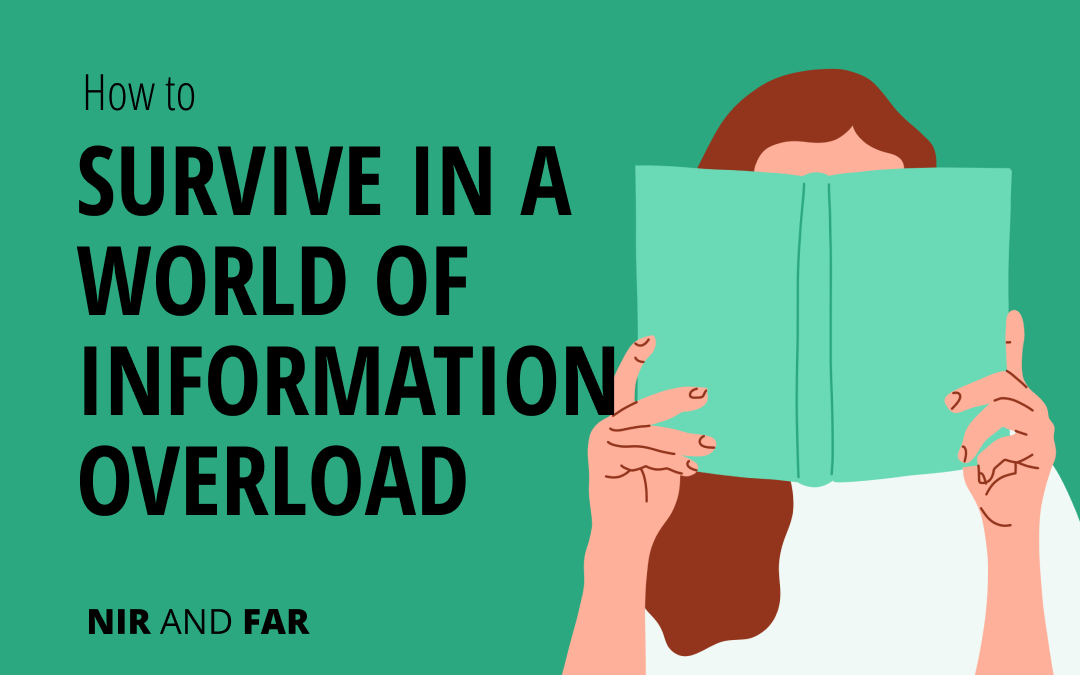We live in a world of too much information, and it’s nothing less than a blessing.
Throughout most of human history, access to knowledge was limited. Power equated to how much information you had access to. Kings built great libraries, and texts were rare and valuable things.
Today, however, what was once scarce is abundant. We’re drowning in information. There are more books to read, blogs to follow, and videos to watch than anyone could consume in countless lifetimes. We have the incredible opportunity to learn nearly anything with a few taps or clicks.
This new ability presents challenges. Now, rather than information, the scarce commodity is attention. The ability to focus on the things that matter while ignoring the things that don’t is a defining trait of people who achieve their dreams.
With the information deluge showing no sign of easing in the years to come, the world is bifurcating into people who allow their time and attention to be controlled and manipulated by others, and those with the power to decide for themselves.
The ability to become Indistractable is a super skill. Without the ability to block out distractions, you’ll be condemned to going through life following someone else’s agenda.
Here are the steps to take to become a master, rather than a slave, of information overload:
Turn your values into time
Mastering information consumption starts with determining your values, then turning your values into time.
Values are attributes of the person we want to be.
Values such as honesty, integrity, self-reliance, and kindness are traits you want to embody rather than something you want to have, like money or social status. If it can be taken away from you, it’s not a value.
A value is like a guiding star; it’s the fixed point we use to help us navigate our life choices, including how we spend our time.
By categorizing our values into three life domains—you, your relationships, and your work—we get two things: an outline of where we spend our time, and a way to think about how we plan our days.
After we come up with our most important values, we must build those values into our calendars. If we don’t plan time to live out our values—e.g., making time to spend with our friends to live out our value of loyalty—we won’t follow through.
Ask yourself, “How would the person I want to become spend their time tomorrow?”
For example, if humility and empathy are some of your values, you may want to make time in your schedule to read up on a social cause you care about.
You may also want to use these same values to filter out information that doesn’t align with your values.
Does reading celebrity news or following hot stock tips really help you live out your values? If not, cut those information sources out of your day.
But what happens after you decide to consume certain kinds of content and find there’s still too much to get through?
Impose constraints
Most people consume information in whatever cracks of time they have in their day, or when they feel bored, lonely, or overwhelmed. Those negative feelings, or internal triggers, are the leading cause of distraction.
We often consume unnecessary information as an emotional escape when we don’t feel right. We tell ourselves we’re doing something good for ourselves by reading the news, that it’s a productive way to spend time. But if it’s not what we planned to do with our time, it is, by definition, a distraction.
Distraction pulls you away from what you intended to do, while traction, on the other hand, draws you toward it.
That’s why the next question after asking yourself, “What do I want to consume?” based on your values is, “When do I want to consume it?”
A schedule imposes a constraint. People who rely on long to-do lists most often don’t accomplish what they say they’re going to do. Why? Because to-do lists don’t factor in time constraints.
You can always add more to a to-do list. A calendar, on the other hand, forces you to make trade-offs.
We all only have 24 hours in a day, so we have to make decisions about how we want to spend our time.
Remember, you can’t call something a distraction unless you know what it distracted you from. That’s why we should all be schedule builders, not to-do list makers.
Knowing you only have a fixed amount of time for catching up on the news, scrolling Instagram, or consuming other forms of content forces you to make some hard choices about what stays and what goes.
Pick how much time in your day you would devote to being “informed.” Thirty minutes? Sixty minutes? You decide. Then ask yourself, “If I only had that much time to catch up with all the information sources in my day, how would I spend it?”
The question prompts you to make trade-offs that will help you stay focused on what matters most: the important things you want to spend your time on, including your family, your friends, and yourself.
Make the most of your time
After deciding your values, turning them into time, and imposing constraints based on your schedule, you should have a much shorter queue of content that’s worth your attention.
But there’s still one more trick to getting the most of your time: multitasking!
But, wait, Nir—isn’t multitasking the enemy of productivity?
It’s true that numerous studies show multitasking degrades performance and productivity. But there are two kinds of multitasking, and knowing the difference can help us get more out of our day.
Single-channel multitasking is the kind humans are really bad at. This occurs when we have multiple sources of information trying to enter our brains at the same time on the same sensory channel.

Googly-eyed chameleon
Unlike a chameleon that can see in two different directions at once using their weird googly eyes, humans need to focus on one visual input at a time. You can’t read two news articles or listen to two podcasts at the same time, for instance.
You can, however, use multi-channel multitasking, by which we receive information on multiple information channels at once.
For instance, you can keep your eyes on the road while driving (using your visual channel) and simultaneously listen to the radio (using your auditory channel) without much trouble.
How can you use multi-channel multitasking to deal with information overload? You can consume content while doing certain other things.
For instance, every time I go to the gym, I use an app called Pocket to read articles to me aloud while I exercise. By listening to articles while I work out, I get to enjoy the content I’ve saved while doing something healthy for my body.
By first turning our values into time, filtering out the superfluous sources of information we don’t have time for, and finding ways to get more out of the time we have by using multi-channel multitasking, we can consume important information without letting it consume us.
Related Articles
- Schedule Maker: a Google Sheet to Plan Your Week
- Habit Tracker Template in Google Sheets
- The Ultimate Core Values List: Your Guide to Personal Growth
- Timeboxing: Why It Works and How to Get Started in 2025
- An Illustrated Guide to the 4 Types of Liars
- Hyperbolic Discounting: Why You Make Terrible Life Choices
- Happiness Hack: This One Ritual Made Me Much Happier

